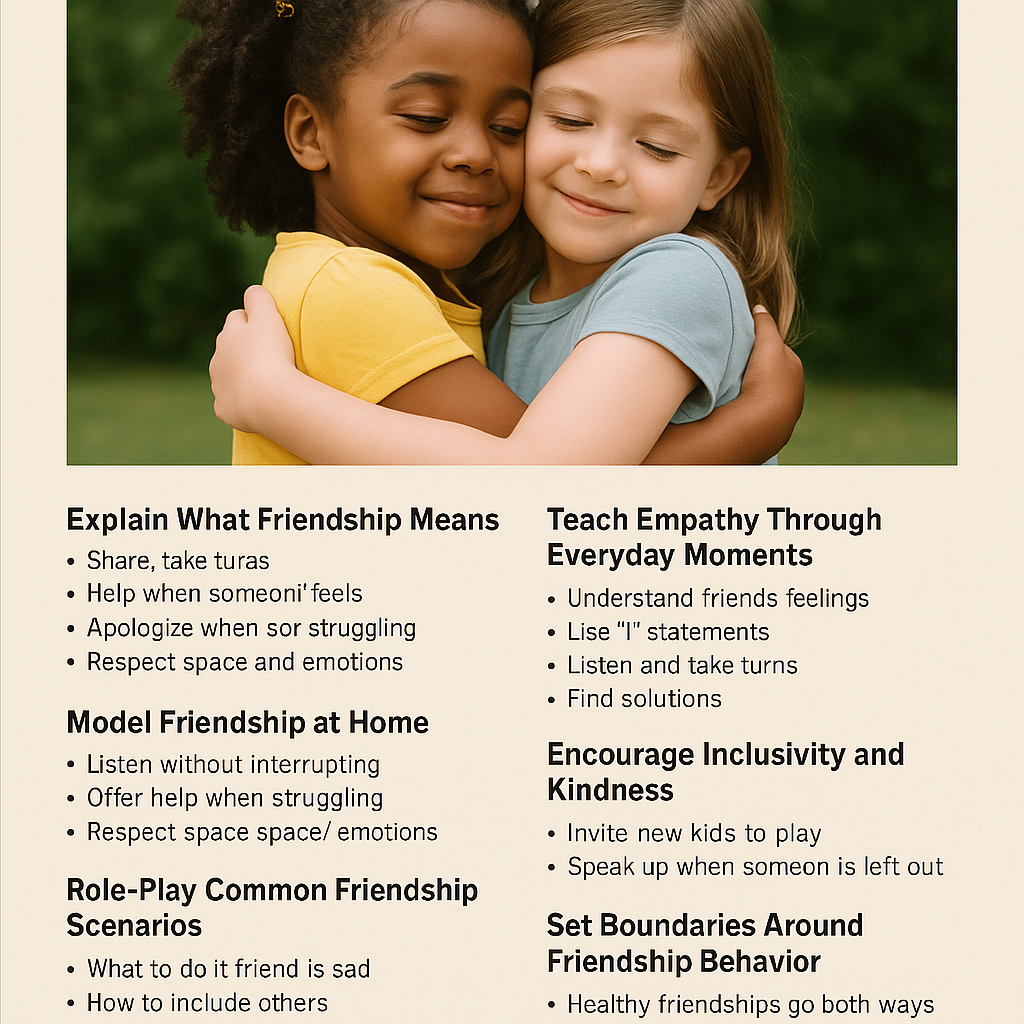Friendship is one of the most valuable parts of childhood. It teaches kids how to communicate, cooperate, handle conflict, and show empathy. But being a good friend doesn’t always come naturally—it’s a skill that can and should be taught.
As a parent or caregiver, you can help your child understand what it means to be a kind, trustworthy, and respectful friend. These lessons will support their emotional development and help them build stronger relationships throughout life.
Here’s how to guide your child in becoming the kind of friend others can count on.
Explain What Friendship Means
Start by helping your child understand what friendship really is—not just playing together, but caring for one another.
Explain that good friends:
- Share and take turns
- Listen and care about each other’s feelings
- Help each other when needed
- Apologize when they hurt someone
- Respect boundaries and differences
You might say:
“Being a good friend means treating others the way you want to be treated.”
Simple definitions help young children grasp big concepts.
Model Friendship at Home
Your child learns how to treat others by watching you. Model positive relationship behaviors with your partner, friends, or even your child.
Demonstrate:
- Listening without interrupting
- Apologizing when you make a mistake
- Offering help when someone is struggling
- Being kind even when you disagree
- Respecting personal space and emotions
When children see kindness in action, they’re more likely to copy it.
Role-Play Common Friendship Scenarios
Kids often benefit from practicing how to be a good friend before they face real-life situations.
Use pretend play or casual conversation to ask:
- “What would you do if your friend was sad?”
- “How can you ask someone nicely to play?”
- “What should you do if two friends are arguing?”
- “How can you help someone feel included?”
This helps your child feel more confident navigating social situations.
Teach Empathy Through Everyday Moments
Empathy—the ability to understand how someone else feels—is the heart of friendship.
Help your child develop empathy by:
- Asking how characters in books or shows might feel
- Talking about how their own actions affect others
- Validating their feelings, so they learn to do the same
Say things like:
- “How do you think your friend felt when that happened?”
- “What can we do to make them feel better?”
- “It looks like she’s having a hard day. How can we help?”
Empathy grows through practice and guidance.
Teach Conflict Resolution Skills
Even the best friendships come with disagreements. Your child needs tools to handle conflict in a respectful and healthy way.
Teach them to:
- Use “I” statements: “I felt sad when you didn’t wait for me.”
- Take turns talking and listening
- Apologize sincerely
- Ask for a break if emotions are too strong
- Brainstorm solutions together
Practice at home and praise your child when they use these skills with others.
Encourage Inclusivity and Kindness
Friendship isn’t just about who your child plays with—it’s about how they treat everyone.
Encourage:
- Inviting new kids to play
- Speaking up when someone is left out
- Not laughing at or teasing others
- Accepting differences in appearance, background, or ability
You can say:
- “It’s kind to include others who might be feeling alone.”
- “You don’t have to be best friends with everyone, but you can always be respectful.”
Inclusivity builds compassion—and strong social character.
Set Boundaries Around Friendship Behavior
Being a good friend doesn’t mean accepting bad behavior from others—or giving up your own needs.
Teach your child that healthy friendships:
- Go both ways—both friends give and receive
- Allow space and time apart
- Respect each other’s boundaries
- Don’t involve manipulation or bullying
Let them know it’s okay to walk away from friendships that feel unkind or unsafe.
Praise Good Friendship Moments
When you see your child showing kindness, fairness, or empathy in friendships, point it out.
Say:
- “That was very thoughtful of you to help your friend when she fell.”
- “You were patient while waiting your turn—great job being a kind friend.”
- “I noticed you comforted your classmate when he was sad. That’s real friendship.”
Positive reinforcement builds their understanding of what friendship looks like.
Share Stories About Friendship
Read books and tell stories that model strong, kind friendships. Stories help children see friendship in action and understand how to handle different situations.
Ask questions like:
- “What made these two characters such good friends?”
- “How did they solve their disagreement?”
- “Have you ever had a friendship like this?”
Books make great conversation starters and emotional tools.
Create Opportunities for Social Growth
Children need practice to build social skills. Support your child in developing friendships by:
- Setting up playdates or group activities
- Involving them in team sports or clubs
- Teaching them how to introduce themselves
- Encouraging them to say “yes” to new social situations (with support)
Give them space to practice, reflect, and improve—just like with any other skill.
Good Friends Are Made, Not Born
Being a good friend isn’t something your child automatically knows how to do. It’s something they learn—with your help, patience, and example.
By teaching kindness, empathy, communication, and boundaries, you’re giving your child the tools to build strong, healthy relationships that can last a lifetime.
Because great friendships don’t just happen—they’re built, moment by moment, with care and love.
